I Love Lucy
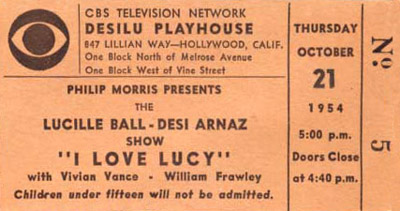
For several years on radio, Lucille Ball had a successful series called My Favorite Husband, in which Richard Denning played her hubby, a banker. In 1951, a lot of radio shows were being converted to TV programs and My Favorite Husband, because of Ms. Ball’s flair for physical comedy, seemed like a natural. But when the subject was raised with Lucy, she startled everyone by insisting that her real husband, Desi Arnaz, play her spouse in the TV show. This was because she felt it might save a troubled marriage if the two of them were together more often…and it did, but only for a while.
But there was another bonus for the Arnaz couple. Desi couldn’t play a banker. He could barely play what he was…a Cuban bandleader. So bringing in Desi meant abandoning the My Favorite Husband format and creating something new. Which meant that Lucy and Desi could own the new show…which they did, starting a TV empire called Desilu. And so they became Lucy and Ricky Ricardo…and very wealthy.
There are many books out about I Love Lucy, the most often-rerun show in television history. They tell of how Desi (or more likely and accurately, his producers) invented the “three-camera” technique for filming a sitcom like a play; of how Desi became work-obsessive running the studio and that eventually harmed their marriage; of how William Frawley and Vivian Vance were so perfect as the landlords, Fred and Ethel Mertz, but hated each other. You can read all that stuff elsewhere.
The above ticket is for a filming on October 21, 1954. This was for an episode called “Getting Ready,” which was about preparations for the Ricardos and the Mertzes to go to Hollywood so Ricky could make his motion picture debut. The finished episode aired on December 13.
The first episode of I Love Lucy aired on October 15, 1951 and the last one aired on May 6, 1957. These were followed by many Lucy-Desi hour long specials, and of course Lucy went on to star in three other series: The Lucy Show, Here’s Lucy and Life With Lucy.
Lennon Sisters Show, The
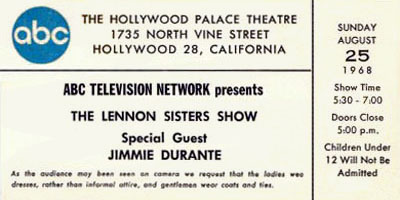
The Lennon Sisters were four toothy young ladies — Dianne, Peggy, Kathy and Janet — who became famous singing on The Lawrence Welk Show. How they got on that series is one of the simplest “rocket to stardom” stories in the history of show business. Lawrence Welk’s son Larry went to school with them and told his father about these sisters who were such fine vocalists. The elder Welk auditioned them and quickly added them to his “musical family,” which meant they got a lot of television exposure but not the highest paychecks.
They appeared on the Welk show from 1955 to 1968 when they decided it was time to do bigger, better-paying jobs. They’d had several successful record albums and this prompted ABC to star them in a special with special guest Jimmy Durante. (That was how Jimmy always spelled it despite the type on the above ticket.) The special did well enough to lead to a weekly series that began in September of 1969. It was called Jimmy Durante Presents The Lennon Sisters Hour.
The series began on a sad note: Six weeks before debut date, the father of the Lennon Sisters was shot to death in a parking lot. The shooter was a deranged fan who believed he was married to Peggy Lennon, and that the father was attempting to break them up. Perhaps that contributed to the low entertainment value of the series, which was cancelled in mid-season.
Hullabaloo
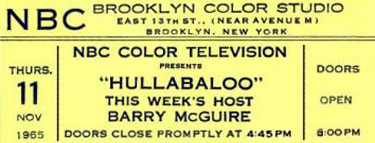
Hullabaloo was a prime-time series on NBC that showcased recording artists of the day. It debuted as an hour series on Tuesday, January 12, 1965 and was later shifted to Monday nights as a half-hour series. It lasted in the Monday slot until August 29, 1966.
Each week, a different guest host would be front and center, introducing that week’s acts and performing with the Hullabaloo dancers, a troupe of well-scrubbed, energetic young people. Future Broadway legends Michael Bennett and Donna McKechnie were among those who did The Frug and The Monkey, but most of the attention went to a particularly uninhibited young lady named Lada Edmund, Jr. The rumor was that in college dorms across the country, male students would gather and watch Ms. Edmund gyrate with the sound on the TV turned off.
The guest list of Hullabaloo was an odd mix of rock performers and mainstream TV personalities. The show booked The Rolling Stones, The Moody Blues and The Yardbirds, but it also booked Don Adams, Soupy Sales, Michael Landon and Vicki Carr. Gary Lewis and the Playboys seemed to pop up every other week. Brian Epstein, who was famous as the manager of The Beatles, consulted and sometimes introduced British acts…but apart from a few snippets of tape, the Beatles themselves were absent from the program.
Some episodes of Hullabaloo were taped at Radio City in New York but by the date on the above ticket, they’d been exiled to the NBC facility in Brooklyn. Rumor has it that this was because of the teenagers who were lining up the night before to be in the audience for the tapings, and cluttering the sidewalks and hallways.
Price is Right, The (1956-1965)
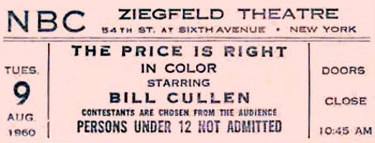
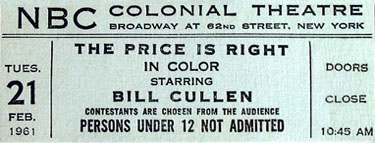
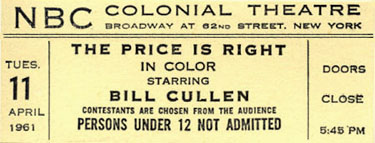

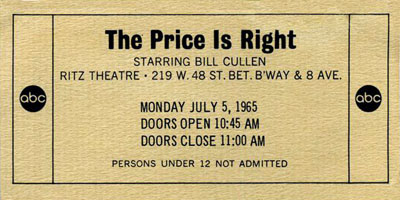
The original version of The Price is Right was a big hit, owing mainly to the twinkling hostmanship of emcee Bill Cullen. It was basically a giveaway show: Four contestants, apparently chosen primarily for their excitability, would “bid” on various items, trying to guess the manufacturer’s suggested retail price. The one who got the closest without going over would win the item plus (usually) an array of bonus prizes.
The show had three main appeals. One was that you at home could play along, seeing how close you could come to guesstimating the prices. The second appeal was watching the winners going through fits of ecstasy and hysteria to score a free refrigerator or trip to the Bahamas. And the third appeal was Cullen, who was easily one of the cleverest, most congenial hosts to ever preside over a game show.
William Lawrence Cullen was born in Pittsburgh, Pennsylvania in 1920 and broke into radio there during his teen years. By 1946, he was the host of the radio game show, Winner Take All, starting an amazing run of game show jobs both as host and panelist. On radio and television, the list included Act It Out, I’ve Got a Secret, Bank on the Stars, Professor Yes ‘n’ No, The Joker’s Wild, Sports Cavalcade, Blankety Blanks, The Love Experts, The $25,000 Pyramid, Blockbusters, Three on a Match, Chain Reaction, Meet Your Match, To Tell The Truth, Child’s Play, Name That Tune, Where Was I?, Down You Go, The Name’s The Same, Who’s There?, Eye Guess, Why?, Give and Take, Hot Potato, Pass the Buck, Winning Streak, How Do You Like Your Eggs?, Place the Face and You’re Putting Me On.
The Cullen version of The Price is Right aired on NBC in daytime from 1956 until 1963, then shifted to ABC where it lasted until 1965. A weekly prime-time version aired from 1957 until 1964, also traversing both networks. As you can see from the above tickets, they moved around. The first ticket is for the Ziegfeld Theater, which NBC acquired in 1955. It had previously housed musicals including the original Kiss Me Kate and Show Boat. (The last legit offering there was an original musical by Lumpy Brannan, who went on to portray Mr. Green Jeans on the Captain Kangaroo TV show.) A few years before NBC sold the theater and it reverted to Broadway fare, The Price is Right moved to the Colonial and then when the show migrated to ABC, to the Ritz, which is now known as the Walter Kerr Theater.
In 1972, the production company (Goodson-Todman) decided to try and revive The Price is Right. It only took a few run-throughs for Mark Goodson to decide that the format was hopelessly outdated and that a major facelift was in order. The game that had been the core of the Cullen version was pared down to a quick pricing round, via which audience contestants earned the right to come up on stage and play the real game. And the rest is history…
New Show, The
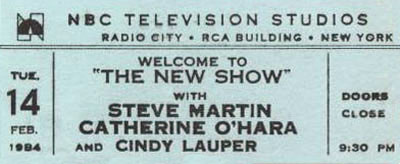
Lorne Michaels left his role as Executive Producer of Saturday Night Live in 1980. In 1984, NBC was in such ratings trouble in prime time that they made him one of those offers he couldn’t refuse. Reportedly, they dangled a staggering sum of cash and total freedom to do whatever he wanted with an hour on Friday nights. The problem, as many would later comment, was that Lorne Michaels didn’t have an idea for a new show, nor the time to conceive one. The New Show debuted on January 6, 1984 and was instantly labelled “Saturday Night Lite” by most critics. It was a largely unstructured hour of sketches and musical acts that was at its best when it most closely resembled the series that had made Michaels famous, offering much the same look and feel, although the show was not broadcast live. It also featured many of the same cast members and guest stars, along with several refugees from SCTV. The last episode aired on March 23. Many people have fond memories of certain sketches, especially several that featured Steve Martin, but Michaels has so far refused to release the series on DVD.






